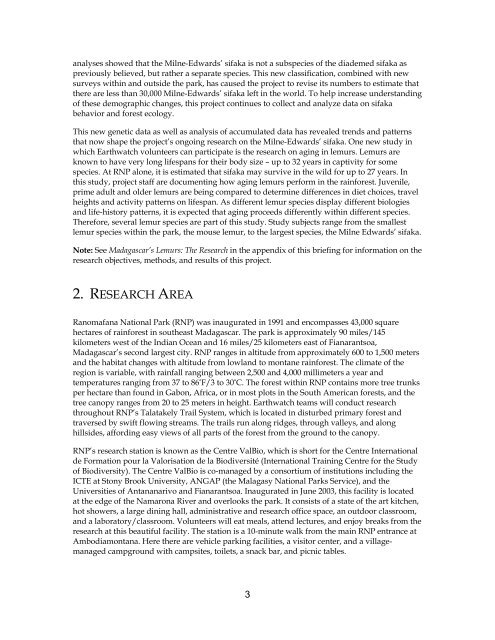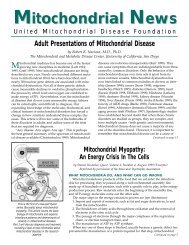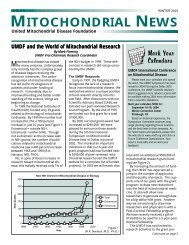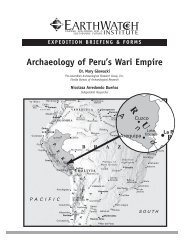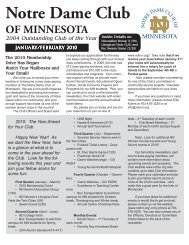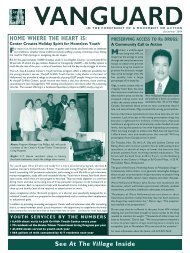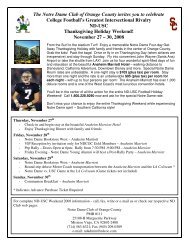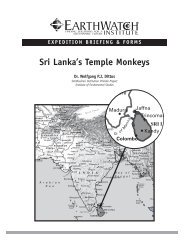Madagascar's Lemurs
Madagascar's Lemurs
Madagascar's Lemurs
Create successful ePaper yourself
Turn your PDF publications into a flip-book with our unique Google optimized e-Paper software.
analyses showed that the Milne-Edwards’ sifaka is not a subspecies of the diademed sifaka as<br />
previously believed, but rather a separate species. This new classification, combined with new<br />
surveys within and outside the park, has caused the project to revise its numbers to estimate that<br />
there are less than 30,000 Milne-Edwards’ sifaka left in the world. To help increase understanding<br />
of these demographic changes, this project continues to collect and analyze data on sifaka<br />
behavior and forest ecology.<br />
This new genetic data as well as analysis of accumulated data has revealed trends and patterns<br />
that now shape the project’s ongoing research on the Milne-Edwards’ sifaka. One new study in<br />
which Earthwatch volunteers can participate is the research on aging in lemurs. <strong>Lemurs</strong> are<br />
known to have very long lifespans for their body size – up to 32 years in captivity for some<br />
species. At RNP alone, it is estimated that sifaka may survive in the wild for up to 27 years. In<br />
this study, project staff are documenting how aging lemurs perform in the rainforest. Juvenile,<br />
prime adult and older lemurs are being compared to determine differences in diet choices, travel<br />
heights and activity patterns on lifespan. As different lemur species display different biologies<br />
and life-history patterns, it is expected that aging proceeds differently within different species.<br />
Therefore, several lemur species are part of this study. Study subjects range from the smallest<br />
lemur species within the park, the mouse lemur, to the largest species, the Milne Edwards’ sifaka.<br />
Note: See Madagascar’s <strong>Lemurs</strong>: The Research in the appendix of this briefing for information on the<br />
research objectives, methods, and results of this project.<br />
2. RESEARCH AREA<br />
Ranomafana National Park (RNP) was inaugurated in 1991 and encompasses 43,000 square<br />
hectares of rainforest in southeast Madagascar. The park is approximately 90 miles/145<br />
kilometers west of the Indian Ocean and 16 miles/25 kilometers east of Fianarantsoa,<br />
Madagascar’s second largest city. RNP ranges in altitude from approximately 600 to 1,500 meters<br />
and the habitat changes with altitude from lowland to montane rainforest. The climate of the<br />
region is variable, with rainfall ranging between 2,500 and 4,000 millimeters a year and<br />
temperatures ranging from 37 to 86 ° F/3 to 30 ° C. The forest within RNP contains more tree trunks<br />
per hectare than found in Gabon, Africa, or in most plots in the South American forests, and the<br />
tree canopy ranges from 20 to 25 meters in height. Earthwatch teams will conduct research<br />
throughout RNP’s Talatakely Trail System, which is located in disturbed primary forest and<br />
traversed by swift flowing streams. The trails run along ridges, through valleys, and along<br />
hillsides, affording easy views of all parts of the forest from the ground to the canopy.<br />
RNP’s research station is known as the Centre ValBio, which is short for the Centre International<br />
de Formation pour la Valorisation de la Biodiversité (International Training Centre for the Study<br />
of Biodiversity). The Centre ValBio is co-managed by a consortium of institutions including the<br />
ICTE at Stony Brook University, ANGAP (the Malagasy National Parks Service), and the<br />
Universities of Antananarivo and Fianarantsoa. Inaugurated in June 2003, this facility is located<br />
at the edge of the Namarona River and overlooks the park. It consists of a state of the art kitchen,<br />
hot showers, a large dining hall, administrative and research office space, an outdoor classroom,<br />
and a laboratory/classroom. Volunteers will eat meals, attend lectures, and enjoy breaks from the<br />
research at this beautiful facility. The station is a 10-minute walk from the main RNP entrance at<br />
Ambodiamontana. Here there are vehicle parking facilities, a visitor center, and a villagemanaged<br />
campground with campsites, toilets, a snack bar, and picnic tables.<br />
3


